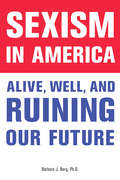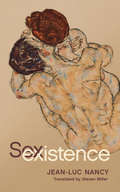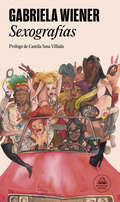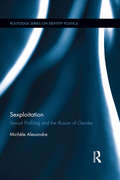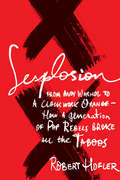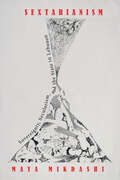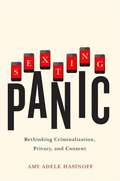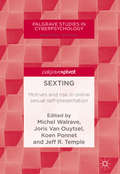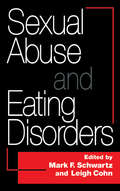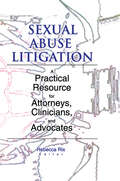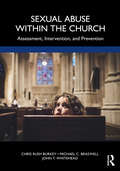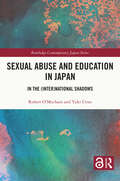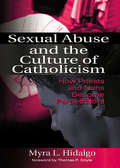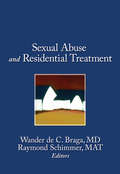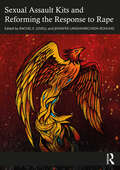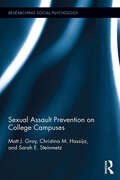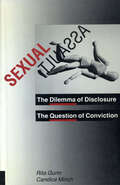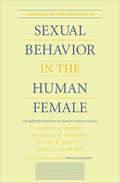- Table View
- List View
Sexism in America: Alive, Well, and Ruining Our Future
by Barbara BergDebunking the many myths about how far women have come and the pervasive belief that American society is postfeminist, this account traces women's status and the assault on their rights from the 1950s--when Newsweek declared, "for the American girl, books and babies don't mix"--to the present, exploring the deception behind women's progress and contextualizing the current situation. The legacy of the women's movement is being short-circuited in every aspect of life, as evidenced by statistics such as the growing wage gap between men and women that begins right after college, the U.S. ranking of 31st in world gender equity--behind Latvia and the Philippines--as well as trends ranging from rising medical insurance costs to shortening life expectancy for women. This passionate, extensively documented, humorous, and persuasive argument is simultaneously enlightening, frightening, and revitalizing and helps women understand where they are and why and how they can move beyond marginalizing strategies.
Sexistence
by Jean-Luc NancySex, more than just a part of our experience, troubles our conceptions of existence. Drawing on a fascinating array of sources, ancient and modern, philosophical and literary, Jean-Luc Nancy explores and upholds the form-giving thrust of the drive. Nancy reminds us that we are more comfortable with the drama of prohibitions, ideals, repression, transgression, and destruction, which often hamper thinking about sex and gender, than with the affirmation of an originary trouble at the limits of language that divides being and opens the world.Sexistence develops a new philosophical account of sexuality that resonates with contemporary research on gender and biopolitics. Without attempting to be comprehensive, the book ranges from the ancient world through psychoanalysis to discover the turbulence of the drive at the heart of existence.
Sexo con una mujer mayor
by L-L-RyanMiki era al menos 20 años mayor que yo y no soy pollito de primavera. Tengo nietos Ella fue la criatura más sexual que he conocido. Ella podría tener organismos casi continuos. Su hobby era cultivar plantas eróticas y luego se convirtió en mí.
Sexografías
by Gabriela WienerEdición ampliada de las crónicas sexuales de Gabriela Wiener, un recorrido temerario y trepidante por el lado más salvaje del periodismo narrativo, con prólogo de Camila Sosa Villada. «Gabriela Wiener es una fuerza de la naturaleza y así escribe: un terremoto sobre nuestros tabúes y prejuicios. Este es un libro inteligente y delicioso».María Fernanda Ampuero «Gracias a Belcebú por la mano atrevida de Gabriela Wiener y por su libro, que desorienta a cualquiera que cree sabérselas todas sobre sexo. [...] Este libro es una criatura con sus propios caprichos, que conoce bien el camino al éxtasis, que entristece y desboca como cualquiera de nosotros. Una Wiener que se queda sobre nuestro pecho derramando preguntas mortales como un veneno. La incógnita sobre el sexo, sobre su estrategia para sobrevivir, renovarse y asegurar su perpetuidad. Cuán lejos podemos llegar para sentir algo, qué tan abajo, qué tan arriba y dónde se refugia nuestro placer. A pesar de haber sido escrito durante las últimas dos décadas, Sexografías me hizo pensar en lo necesario que es el sexo para nuestra cultura. Lo tengamos o no, lo deseemos o no. [...] ¿Que si me calenté al leer Sexografías? Sí. ¿Leyendo crónicas periodísticas? Sí. [...] Este libro no pide piedad, pero exige que no mezquinemos cuerpo como lectores. Si la escritora vende así su alma al diablo por la palabra, por qué nosotros no responder con la misma entrega».Del prólogo de Camila Sosa Villada Reseñas:«Gabriela Wiener es un fenómeno de la naturaleza que es un fenómeno de la literatura que es un fenómeno en sentido lato. Una vez, siendo jefa de redacción de un diario español, leí Sexografías y la llamé por teléfono. La llamé un minuto después de cerrar el libro, urgentemente. Cuando la tuve delante, reconocí a la jefa de la tribu. Otra vez leí Sexografías y abandoné el periodismo durante mucho tiempo. Hoy leo Sexografías y confirmo aquellas sospechas: es posible anudar creación, periodismo, compromiso y humor. Ella lo hace aquí. Gabriela Wiener existe».Cristina Fallarás «Gabriela Wiener se pasea por los mundos del sexo como una antropóloga curiosa que visita un planeta de alienígenas: observadora, detallista, divertida, aguda y atinada traductora del disparate de la vida».Rosa Montero «Este libro me cambió la vida y me la vuelve a cambiar cada vez que lo releo. En Sexografías, el sexo es un camino sutil que Wiener toma para armar una voz y dibujar una teoría implícita y profunda sobre el mundo y el sentido de experimentarlo, vivirlo y conquistarlo».Tamara Tenenbaum «Tan deliciosamente escrito como excitante y riguroso: libro de culto para el cuerpo, el deseo, el goce y el fin de los traumas. Leer Sexografías es disfrutar de una escritora exquisita yferoz».Cristian Alarcón «La nueva edición de este clásico contemporáneo multiplica su interés original gracias a la calidad y el jugo de sus renovaciones. Sexografías se nos presenta más ágil y valeroso que nunca».Elisa Victoria
Sexploitation: Helping Kids Develop Healthy Sexuality in a Porn-Driven World
by Cindy PierceAs surprising as it may be to parents, young people today are immersed in porn culture everywhere they look. Through Internet porn, gaming, social media, and advertising, kids today have a much broader view of social and sexual possibilities, which makes it difficult for them to establish appropriate expectations or to feel adequate in their own sexuality. Parents tend to convince themselves that their children are immune to cultural influences, wait until it comes up, or hope schools and pediatricians will address the issues. Educators and doctors may be able to start the conversation but it is fundamentally a parent's job to provide information about sex and relationships early and often to help young people find their way through their social and sexual lives. Delaying the necessary but awkward conversations with their kids leaves them vulnerable. The media, marketers, and porn and gaming industries are eager to step in anywhere parents choose to hold back. Sexploitation exposes the truth to parents, kids, educators, and the medical profession about the seen and unseen influences affecting children, inspiring parents to take the role as the primary sexuality educator. With more information, parents will gain conviction to discuss and develop values, expectations, boundaries, and rules with their kids. Kids who enter their teens with accurate information and truths stand a better chance of developing an "inner compass" when it comes to sex and relationships, which sets them up for a healthy adulthood. In her comic and straightforward style, Pierce brings together the latest research with anecdotal stories shared with her by high school and college students in the thick of it. Above all else, her goal is to get people to develop more comfort around those difficult conversations so that kids gain more confidence and courage about drawing boundaries based on their own values not those put upon them.
Sexploitation: Sexual Profiling and the Illusion of Gender (Routledge Series on Identity Politics)
by Michèle AlexandreMichèle Alexandre’s innovative study examines how sexual profiling represses, oppresses, and hinders various aspects of life for both genders, and explores the ways in which the law and the community can help eradicate the practice of sexual profiling. Alexandre defines "sexploitation" as the perpetuation of myths and stereotypical notions regarding men and women in order to further an agenda of oppression and subordination in certain spheres of society. The most popular means through which this sexploitation is achieved is through a method Alexandre coins as "sexual profiling." She argues that sexual profiling ultimately stifles the growth of our society by creating inefficient as well as oppressive systems, and that its eradication can help increase the productivity as well as the morale of society. Alexandre opens the book by exploring in detail the various ways in which normative views of gender are constructed and perpetuated through media and societal norms. She then focuses on the ways in which recent legal opinions and developments contribute to perpetuate these restrictive and oppressive norms. Finally, Alexandre outlines a plan to help eliminate the presence of these destructive norms and attitudes from different sectors of society.
Sexplosion
by Robert HoflerAfter the sexual revolution came the sexual explosionThe six years between 1968 and 1973 saw more sexual taboos challenged than ever before. Film, literature, and theater simultaneously broke through barriers previously unimagined, giving birth to what we still consider to be the height of sexual expression in our pop culture: Portnoy's Complaint, Myra Breckinridge, Hair, The Boys in the Band, Midnight Cowboy, Last Tango in Paris, and Deep Throat.In Sexplosion, Robert Hofler weaves a lively narrative linking many of the writers, producers, and actors responsible for creating these and other controversial works, placing them within their cultural and social frameworks. During the time the Stonewall Riots were shaking Greenwich Village and Roe v. Wade was making its way to the Supreme Court, a group of daring artists was challenging the status quo and defining the country's concept of sexual liberation. Hofler follows the creation of and reaction to these groundbreaking works, tracing their connections and influences upon one another and the rest of entertainment.Always colorful and often unexpected, Sexplosion is an illuminating account of a generation of sexual provocateurs and the power their works continue to hold decades later.
Sextarianism: Sovereignty, Secularism, and the State in Lebanon
by Maya MikdashiThe Lebanese state is structured through religious freedom and secular power sharing across sectarian groups. Every sect has specific laws that govern kinship matters like marriage or inheritance. Together with criminal and civil laws, these laws regulate and produce political difference. But whether women or men, Muslims or Christians, queer or straight, all people in Lebanon have one thing in common—they are biopolitical subjects forged through bureaucratic, ideological, and legal techniques of the state. With this book, Maya Mikdashi offers a new way to understand state power, theorizing how sex, sexuality, and sect shape and are shaped by law, secularism, and sovereignty. Drawing on court archives, public records, and ethnography of the Court of Cassation, the highest civil court in Lebanon, Mikdashi shows how political difference is entangled with religious, secular, and sexual difference. She presents state power as inevitably contingent, like the practices of everyday life it engenders, focusing on the regulation of religious conversion, the curation of legal archives, state and parastatal violence, and secular activism. Sextarianism locates state power in the experiences, transitions, uprisings, and violence that people in the Middle East continue to live.
Sexting Panic: Rethinking Criminalization, Privacy, and Consent
by Amy Adele HasinoffSexting Panic illustrates that anxieties about technology and teen girls' sexuality distract from critical questions about how to adapt norms of privacy and consent for new media. Though mobile phones can be used to cause harm, Amy Adele Hasinoff notes that the criminalization and abstinence policies meant to curb sexting often fail to account for distinctions between consensual sharing and malicious distribution. Challenging the idea that sexting inevitably victimizes young women, Hasinoff argues for recognizing young people's capacity for choice and encourages rethinking the assumption that everything digital is public. Timely and engaging, Sexting Panic analyzes the debates about sexting while recommending realistic and nuanced responses.
Sexting, Privatsphäre und (Bild-) Rechte im Internet: SPuR - Ein Präventionsprogramm für die 6. und 7. Jahrgangsstufe
by Eva-Maria Schiller Annika Endres Chantal NestlerDieses Fachbuch enthält ein schulklassenbasiertes Durchführungsmanual für Lehrkräfte, Schulsozialarbeiter:innen, Schulpsycholog:innen und weitere an Schulen tätige Trainingskräfte. Das Ziel des SPuR-Präventionsprogramms ist es, frühzeitig einen kompetenten Umgang mit Bildmaterial im Netz zu fördern und der missbräuchlichen Verbreitung von freizügigen Fotos vorzubeugen. Zielgruppe des Programms sind Schüler:innen der 6. und 7. Jahrgangsstufe. In fünf Modulen beschäftigen sich die Schüler:innen mit den Themen Privatsphäre im Internet und dem Austausch von freizügigen Fotos über soziale Medien (sog. Sexting). Was möchte man von sich selbst preisgeben? Welche Gefahren gibt es? Wie kann man sich schützen? Und was kann man tun, wenn ein freizügiges Foto öffentlich geworden ist?Das von Schulpsychologinnen entwickelte, wissenschaftlich fundierte und erprobte SPuR-Präventionsprogramm wird im Buch ausführlich und praktisch erläutert, so dass Sie das medienpädagogische Programm selbstständig an Ihrer Schule durchführen können. Das Buch enthält zudem Hinweise für die Elternarbeit und ergänzende Online-Materialien.
Sexting: Motives And Risk In Online Sexual Self-presentation (Palgrave Studies In Cyberpsychology Ser.)
by Michel Walrave Koen Ponnet Joris Van Ouytsel Jeff R. TempleIn the current debate around sexting, this book gives a nuanced account of motives, contexts and possible risks of intimate digital communication. Authors discuss how social media shape new dating opportunities through apps and dating sites, how sexting fits within individual’s relational and sexual development. They examine the relationships between sexting, health and sexual risk behaviours and focusing on adolescents, further highlight which role parents can play in relational and sexual education.Chapters cover topics such as abusive sexting behaviours in the context of dating violence and slut shaming, media discourses concerning sexting and the legal framework in several countries that shape the context of sexting. This edited collection will be of great interest to academics and students of communication studies, psychology, health sciences and sociology, as well as policy makers and the general public interested in current debates on how social media are used for intimate communication.
Sexual Abuse And Eating Disorders
by Leigh Cohn Mark F. SchwartzFirst published in 1996. Routledge is an imprint of Taylor & Francis, an informa company.
Sexual Abuse Litigation: A Practical Resource for Attorneys, Clinicians, and Advocates
by Rebecca A RixPrepare a solid case with advice from successful litigators!Ideal for use as a legal guide or a practical reference, Sexual Abuse Litigation examines how professionals can responsibly and effectively advocate on behalf of adult survivors of child sexual abuse (CSA) in the midst of the controversies surrounding recovered memories. This comprehensive book places the current recovered-memory controversy in historical context and examines how various psychological and medical conceptions of trauma have shaped public opinion and the construction of delayed discovery statutes of limitations. For lawyers, advocates, clinicians, and CSA survivors, Sexual Abuse Litigation offers practical advice in clear prose and an easy-to-use format. Summaries, charts, legal practice tips, and samples of actual testimony make this book an invaluable reference tool. It also tabulates the statutes of limitations for sexual abuse cases in all fifty states. In Sexual Abuse Litigation, experienced litigators will guide you through the phases of the legal process, offering practical suggestions on: case evaluation and development the pitfalls and opportunities of professional cooperation between therapists and lawyers the effective use of plaintiff expert witnesses strategies for countering the ”false memories” defense the identification of insurance benefits for injuries related to CSA techniques for cross-examining expert witnesses for the defense vital networking information, including resource referrals for adult survivors, help with appellate cases, and information on abuse by clergy and other professionalsOffering strategies for sustaining the admissibility of the CSA survivor's testimony and how to maintain focus on the question of whether abuse occurred, Sexual Abuse Litigation will give you or your client the necessary information on how to successfully prepare for a CSA case and face the challenges of such cases in the courtroom.
Sexual Abuse Within the Church: Assessment, Intervention, and Prevention
by John T. Whitehead Michael C. Braswell Chris Rush BurkeyThis book takes a holistic approach by providing insight into the behavior and nature of sex offenders within the church. The text covers various types of sex offenders as well as their criminal propensities and methods of acquiring victims. Warning signs associated with sex crimes within the church are explained as well as security measures and prevention strategies that church leaders and criminal justice professionals can utilize to minimize risk to congregants. Discussion questions and case study scenarios are provided to allow the reader to examine relevant issues and explore a range of potential solutions and interventions. This comprehensive book is intended for criminal justice academicians who teach courses on sex crimes and sex offenders, criminal justice agents (police and investigators), seminary professors and students, and clergy members. It can also assist security teams, church board members, leaders, and teachers in developing intervention and prevention strategies.
Sexual Abuse and Education in Japan: In the (Inter)National Shadows (Routledge Contemporary Japan Series)
by Robert O'Mochain Yuki UenoBringing together two voices, practice and theory, in a collaboration that emerges from lived experience and structured reflection upon that experience, Ueno and O’Mochain show how entrenched discursive forces exert immense influence in Japanese society and how they might be most effectively challenged. With a psychosocial framework that draws insights from feminism, sociology, international studies, and political psychology, the authors pinpoint the motivations of the nativist right and reflect on the change of conditions that is necessary to end cultures of impunity for perpetrators of sexual abuse in Japan. Evaluating the value of the #MeToo model of activism, the authors offer insights that will encourage victims to come out of the shadows, pursue justice, and help transform Japan’s sense of identity both at home and abroad. Ueno, a female Japanese educator and O’Mochain, a non-Japanese male academic, examine the nature of sexual abuse problems both in educational contexts and in society at large through the use of surveys, interviews, and engagement with an eclectic range of academic literature. They identify the groups within society who offer the least support for women who pursue justice against perpetrators of sexual abuse. They also ask if far-right ideological extremists are fixated with proving that so called “comfort women” are higaisha-buru or “fake victims.” Japan would have much to gain on the international stage were it to fully acknowledge historical crimes of sexual violence, yet it continues to refuse to do so. Ueno and O’Mochain shed light on this puzzling refusal through recourse to the concepts of ‘international status anxiety’ and of ‘male hysteria.’ An insightful read for scholars of Japanese society, especially those concerned by its treatment of women.
Sexual Abuse and the Culture of Catholicism: How Priests and Nuns Become Perpetrators
by Myra L HidalgoAn inside look at the reasons Catholic priests and nuns commit sexual abuseSexual Abuse and the Culture of Catholicism digs beneath the public scandals to explore the underlying causes of sexual abuse by priests and nuns from the unique perspective of an abuse victim/survivor who is an experienced mental health practitioner and social science researcher. This powerful book includes the author’s personal account of sexual abuse by a nun and her years of struggle to recover. Passionate but scholarly and objective, the book advocates the need for healing dialogue, empirical research, and informed prevention strategies to bring a meaningful resolution to the crisis of sexual abuse in the church.Popular explanations for the reasons behind the crisis have included issues related to celibacy, homosexuality, the power structure of the church, and poor seminary screening practices. But none of these theories are supported by research nor can they explain why Catholic priests and nuns may be more likely to abuse children that other adults in positions of trust. Sexual Abuse and the Culture of Catholicism uses a complex, systemic approach to draw parallels between the church as a human system and a family that has experienced incest, presenting a model for a sexual trauma cycle in the church based on systemic sexual shame passed down through the beliefs and practices of Catholicism. Sexual Abuse and the Culture of Catholicism examines: the prevalence and characteristics of sexual abuse by Catholic priests and nuns compared to sex offenders in the general population celibacy, homosexuality, and the power structure of the church as contributing factors in the sexual abuse crisis an analogy of the church as a family in which incest occurs the effects and causes of sexual offending from one generation to the next how current research on sexual offending applies to sexual abuse by priests and nuns healing and empowerment for those affected by religious-based sexual trauma reform and renewal within the Catholic Church and much moreSexual Abuse and the Culture of Catholicism is a unique and important resource for clergy, religious order, and lay leaders in the Catholic Church and other Christian denominations; social science researchers; social workers and mental health professionals; lay and religious members of the Catholic Church; and anyone recovering from religious-based sexual trauma.
Sexual Abuse in Residential Treatment
by Mat Raymond Schimmer Wander BragaSexual Abuse in Residential Treatment provides comprehensive information on behavioral manifestations of sexual abuse in residential settings and the safety and developmental needs, staff training, and management strategies necessary to protect both residents and staff. Chapters containing vivid case studies that describe problematic episodes, discussions of research projects, and proposals for agency sexuality policies, safe facility management, and staff training contribute to a balanced presentation of the framework in which sexual manifestations are embedded.Professionals in residential treatment will learn how to identify the most common sexual, sexualized, and sexually abusive behaviors and from whence they derive. Sexual Abuse in Residential Treatment provides specific suggestions for policy and program design, recommends operational framework for safe management of treatment facilities, and describes practical staff supervision and training modules. With an emphasis on clinical practice, descriptions of common problems and proposed solutions together with a broad philosophical basis to guide policy setting will benefit professionals in agencies interested in developing customized organizational and treatment plans. Practitioners, policymakers, and decision makers in residential programs, inpatient psychiatric units, community-based group homes, court-related youth shelters, and correctional facilities for the rehabilitation of behaviorally disturbed youth presenting sexual problems will find a wealth of information on a wide range of topics such as: normal, pathological, and abusive sexual behavior in residential treatment staff responses to sexual behavior, training, and supervision needs frequency and quality of sexual behaviors of latency-aged children safe management to prevent toxic manifestations of sexuality management of sex abuse allegations in the residential program recommendations for agency sexuality policies selection criteria and program features for specialized offender treatment the heterogeneity of phenomena classified as “sex abuse” values conflicts involved in the design of programs and policiesSexual Abuse in Residential Treatment provides descriptive commentary concerning sexual behavior of youth in residential treatment from various points of view including development, values, therapeutic milieu, safety, training, and clinical experience. Such a diverse approach makes this a valuable guide for practitioners, as well as program directors, unit supervisors, case managers, staff trainers, faculty in child care studies, and child protective services staff.
Sexual Abuse in Sport
by Helen OwtonThis book is about sexual abuse in sport, and specifically about one girl's experience of long-term chronic abuse in sport. A 'non-conventional' approach is employed to explore the experiences of a female athlete named Bella who was groomed, sexually abused by her male coach, and then subjected to years of athlete domestic violence. Through a collaborative auto-ethnography process, these experiences are reported through vignettes and selected poems seeking to involve the reader in the grooming process of a young female athlete, so that they might react from the different social positions they currently occupy. Bella's story acts as a pedagogical resource in ways that stimulate ethical discussions and enhance knowledge of sexual abuse in sport, by assisting those involved to better understand their own 'field' and the dynamics of abuse within it, in order to develop effective abuse prevention strategies.
Sexual Assault Kits and Reforming the Response to Rape
by Rachel E. Lovell Jennifer Langhinrichsen-RohlingSexual Assault Kits and Reforming the Response to Rape curates the current state of untested sexual assault kit research and highlights emerging best practices by exploring the past, the present, and the future of our collective response to rape. This book is the first to address the most critical topics related to untested sexual assault kits and the Department of Justice’s Sexual Assault Kit Initiative, bringing together leading US scholars, practitioners, policy makers, and survivors. In a series of well-researched and thoughtful thematic chapters, the book explores the current state of knowledge related to untested kits, survivors, and perpetrators, while also documenting fundamental and necessary changes in how societal systems respond to rape. It provides an opportunity to learn from our past, highlight what we could do differently now, and envision a better future for victims of rape and those tasked with ensuring justice. It may also serve as a cautionary tale for those jurisdictions that have yet to face their backlog or who have failed to embrace the practice and policy changes that have emerged from the Sexual Assault Kit Initiative. Sexual Assault Kits and Reforming the Response to Rape is essential reading for practitioners (including law enforcement, prosecutors, victim advocates, mental health providers, forensic nurses, and forensic scientists), stakeholders, legislators, and policy makers. It will also be of interest to upper-level students and scholars working on interpersonal violence, gender-based violence, and forensic nursing in social/behavioral science fields.
Sexual Assault Prevention on College Campuses (Researching Social Psychology)
by Matt J. Gray Christina M. Hassija Sarah E. SteinmetzSexual assault continues to be a problem on college campuses despite greater attention to reducing rates of assault and an increased presence in the public discourse. Programming has been historically directed towards women by providing them with information about how to keep themselves safe rather than confronting a climate conducive to sexual violence. This important volume illuminates the urgency of combating sexual violence on college campuses. The authors depict in detail empirically supported approaches to combating climates conducive to sexual violence and ways to empower all members of the campus community to actively prevent sexual violence.
Sexual Assault and Abuse: Sociocultural Context of Prevention
by Robert E Hess Carolyn F SwiftPrevention of a chronic societal problem such as sexual victimization requires looking beyond individuals to the systemic factors that maintain the problem. Sexual Assault and Abuse addresses the need to change social and cultural beliefs and practices that permit the sexual victimization of women and children. Potential rapists and victims are viewed within the context of the social and cultural factors that shape sexual behavior. The book discusses rape prevention approaches ranging from changing individuals and groups to changing the social and cultural factors that permit and promote sexual victimization.Research in the social sciences, in education, and in the media documents the promise as well as the problems with efforts to change social and cultural beliefs and practices to create a sexually safe society. Sexual Assault and Abuse integrates recent advances in research on sexual assault and prevention into strategies to prevent sexual victimization, with a focus on the role of sociocultural factors.In Sexual Assault and Abuse, editor Carolyn F. Swift brings together authors who thoughtfully examine the perpetrators and victims of sexual assault/abuse in an effort to change or obliterate sociocultural factors which maintain or promote this behavior. Topics covered include: the sociocultural context of sexual assault/abuse the need to develop multiple-level prevention programs development of sexually abusive behavior in men and boys the relationship between pornography and sexual assault/abuse the need for culturally-sensitive prevention programs the significance of sexual revictimization in the lives of African American women an ecological approach to the prevention of sexual harassment utilization of social science research to develop public policy on pornography use of public information campaigns to prevent intrafamilial child sexual abuse within Hispanic familiesSexual Assault and Abuse identifies sociocultural risks associated with sexual assault/abuse and explores ways to reduce these risks, from a prevention perspective, for diverse populations. Risks addressed include gender inequities, pornography, worksites hostile to women, previous victimization in African American females, sexist and racist beliefs, and media violence against women. Prevention programs range from interventions to stop the development of sexually abusive behavior in boys and men, through programs that take account of ethnic diversity in language, history, and culture, to those that promote empowerment of women. By addressing the environmental context in which sexual assault occurs, the authors in Sexual Assault and Abuse broaden their focus to incorporate both potential perpetrators and potential victims in an ecological perspective which permits new approaches to prevention. This book is of special interest and value to academics and practitioners of psychology, psychiatry, and social work, therapists and counselors, women&’s studies professionals, sociologists, anthropologists, feminists, rape crisis center staff and volunteers, and battered women center staff and volunteers.
Sexual Assault and Sexual Harassment in the U.S. Military
by Andrew R. Morral Terry L. Schell Kristie L. GoreThe Department of Defense Sexual Assault Prevention and Response Office asked the RAND Corporation to independently assess rates of sexual assault, sexual harassment, and gender discrimination in the military. This volume presents the results of methodological investigations into sources of potential bias in estimates produced from the 2014 RAND Military Workplace Study for active- and reserve-component members in the U.S. military.
Sexual Assault and Sexual Harassment in the U.S. Military: Volume 5. Estimates for Installation- and Command-Level Risk of Sexual Assault and Sexual Harassment from the 2014 RAND Military Workplace Study
by Andrew Gelman Andrew R. Morral Terry L. Schell Jessica Hwang Matthew CefaluThe Department of Defense Sexual Assault Prevention and Response Office asked the RAND Corporation to conduct an assessment of the rates of sexual assault, sexual harassment, and gender discrimination in the U.S. military. This volume presents survey estimates of how risk of sexual assault and sexual harassment varies across military installations and major commands using data from the 2014 RAND Military Workplace Study.
Sexual Assault: The Dilemma of Disclosure, The Question of Conviction
by Rita F. Gunn Candice MinchOnly a small percentage of all cases of sexual assault are reported to the police. Why do so many women decide not to report an assault? And what happens to the assailant when a case is reported and charges are laid? In this volume Rita Gunn and Candice Minch explore the answers to these questions, basing their analysis on the most comprehensive data available on sexual assault in Canada. Through interviews with victims of sexual assault, they analyze the factors that influence the women to report an attack or keep silent. Society still places the responsibility on women to avoid being sexually assaulted, so the victim is caught in a dilemma when deciding whether to disclose an assault. The authors then look at what happens when a sexual assault is reported. They follow a sample of assaults from the initial police report through to the final disposition of the case, demonstrating that: only 10 percent of the original charges resulted in conviction; 20 percent were reduced to lesser charges; over 70 percent of the charges were filtered out of the criminal justice system before trial; and societal attitudes which blame victims for the offence extend into the legal system. Finally, the authors offer an assessment of the effects of the 1983 sexual assault legislation on the processing and ultimately on the reporting of sexual offences. They conclude that law reform is necessary but not sufficient in itself. “The law is only as innovative as the individuals who use, interpret, and apply it.” This volume provides a valuable analysis of sexual assault as it affects the victim and the assailant.
Sexual Behavior in the Human Female (Encounters: Explorations in Folklore and Ethnomusicology)
by Alfred C. Kinsey Wardell B. Pomeroy Clyde E. Martin Paul H. GebhardThe groundbreaking Kinsey Report study on female sexuality from &“one of the most influential figures in American intellectual history&” (The New York Times). Originally published in 1953, the material presented in Sexual Behavior in the Human Female was derived from personal interviews with nearly 6,000 women; from studies in sexual anatomy, physiology, psychology, and endocrinology. The study revealed the incidence and frequency with which women participate in various types of sexual activity and how such factors as age, decade of birth, and religious adherence are reflected in patterns of sexual behavior. The authors make comparisons of female and male sexual activities and investigate the factors which account for the similarities and differences between female and male patterns of behavior and provide some measure of the social significance of the various types of sexual behavior. &“[It] shocked the world in 1953 with its explicit revelations. Countries banned it. Churches berated it. Some scholars scoffed . . . but it was an instant success, selling 270,000 copies in less than a month . . . [Kinsey] made headlines around the globe with his findings on such things as masturbation, sex before marriage and adultery.&”—CBSNews.com
